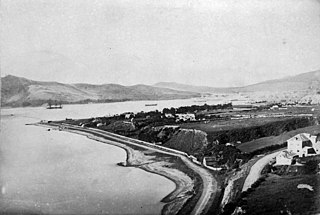
Eastbourne is a suburb of Lower Hutt, a part of Wellington, New Zealand. Lying beside the sea, it is a popular local tourist destination via car from Petone or from ferry crossings from central Wellington. An outer suburb, it lies on the eastern shore of Wellington Harbour, five kilometres south of the main Lower Hutt urban area and directly across the harbour from the Miramar Peninsula in Wellington city. A narrow exposed coastal road connects it with the rest of Lower Hutt via the Eastern Bays and the industrial suburb of Seaview. It is named for Eastbourne in England, another seaside town known as a destination for day-trips.
Alicetown is a central suburb of Lower Hutt located at the bottom of the North Island of New Zealand.

Belmont, a suburb of Lower Hutt, to the north of Wellington in the North Island of New Zealand, lies on the west bank of the Hutt River, on State Highway 2, the Wellington-Hutt main road, and across the river from the centre of Lower Hutt.
Waterloo is an eastern suburb of Lower Hutt, Wellington. It is named after the Battle of Waterloo won by the Duke of Wellington in 1815.

Moera, a suburb of the city of Lower Hutt in New Zealand, forms part of the urban area of greater Wellington.
Ebdentown, a suburb of Upper Hutt located in the lower North Island of New Zealand, near Upper Hutt Central.
Hutt Central, a suburb of the city of Lower Hutt in New Zealand, forms part of the urban area of greater Wellington. It includes the Lower Hutt CBD.

Kelson is a suburb of Lower Hutt in Wellington, New Zealand. It is situated on the western hills of the Hutt Valley. To the west of the suburb lies the Belmont Regional Park, while to the east runs the Hutt River and State Highway 2.
Boulcott is a central suburb of Lower Hutt City situated in the south of the North Island of New Zealand. The suburb lies about a kilometre north-east of the Lower Hutt CBD.
Tirohanga is a suburb of Lower Hutt City situated at the bottom of the North Island of New Zealand. The suburb is located on the western side of the Hutt River and State Highway 2.
Manor Park, a northern suburb of Lower Hutt City, lies in the south of the North Island of New Zealand. The suburb separates the western bank of the Hutt River from State Highway 2.

Waiwhetū is an eastern suburb of Lower Hutt in the Wellington Region situated in the south of the North Island of New Zealand.
Maungaraki is a suburb of Lower Hutt City situated at the bottom of the North Island of New Zealand. The suburb is located on the western hills of the Hutt Valley with access to the area via State Highway 2 and offers extensive views of Wellington harbour and Matiu/Somes Island. It contains the largest suburban development on the Hutt Valley's western escarpment that runs along the Wellington Fault.
Gracefield is an industrial suburb of Lower Hutt City, located at the bottom of the North Island of New Zealand.

Korokoro, a suburb of Lower Hutt City, lies in the south of the North Island of New Zealand. The suburb occupies part of the western hills of the Hutt Valley; its eastern slopes overlook Petone and the Wellington harbour.

Parkway is a suburb of Wainuiomata, part of Lower Hutt city situated in the lower North Island of New Zealand.
Glendale is a suburb of Wainuiomata, part of Lower Hutt city situated in the lower North Island of New Zealand.
Arakura is a suburb of Wainuiomata, part of Lower Hutt city situated in the lower (southern) North Island of New Zealand.

The Hutt Valley District Health Board is a district health board with the focus on providing healthcare to the cities of Lower Hutt and Upper Hutt in New Zealand.

Pipitea is a central suburb of Wellington, in the Wellington region of New Zealand's North Island.











